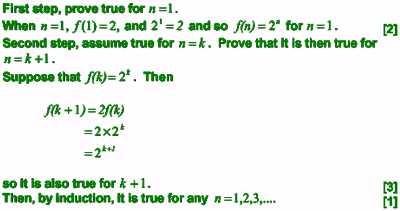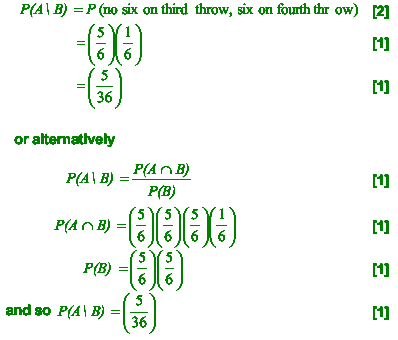|
(a) A bag contains 4 red marbles, 6 blue
marbles and 5 green marbles.
How many ways are there to choose 2 red, 4 blue and 3 green marbles
from the
marbles in this bag? [3]
(a) There are 4C2 =
6 ways to choose 2 red marbles from 4.
There are 6C4 = 15 ways to choose 4 blue marbles
from 4.
There are 5C3 = 10 ways to choose 2 green marbles
from 4. [1]
Total number of ways = 4C2 6C4
5C3 [1]
= 6 × 15 × 10 = 900. [1]
(b) Let R be the relation on the set
Z+ of positive integers defined by aRb if and
only if a = b.
Prove or give a counter-example to determine whether R has the following
properties:
(i) reflexivity; [2]
(ii) symmetry; [2]
(iii) transitivity. [2]

(c) The matrices A and B are given by

(i) Calculate AB [2]
(ii) Calculate BA [2]
(iii) Does (A + B)2 = A2 + 2AB + B2
? Justify your answer. [2]
(c) (i)  [2] [2]
Subtract 1 mark for every error up to a maximum of 2.
(ii)  [2] [2]
Subtract 1 mark for every error up to a maximum of 2.
(iii)  because because
Alternatively, candidates may calculate (A+B)2 and A2
+2AB +B2
to show that they are not equal.
1 mark for correct answer, 1 mark for justification. [2]
(d) A function, f(n), defined for positive
integers n, satisfies the following conditions:
f(1) = 2
f(n + 1) = 2f(n) for n = 1,2,3,...
Use mathematical induction to prove that f(n) = 2n for
n = 1,2,3,.... [6]
(d)

(e) A man throws a die repeatedly until
a six appears on the top face. Calculate the probability that:
(i) the first six appears on the second throw; [2]
(ii) the first six appears on the fourth throw given that a six does
not appear
on the first two throws. [4]
(e) (i) P(he throws his first six on his
second throws)

(ii) Let A be the event that the first six appears on the fourth throw,
B
be the event that a six does not appear on the first two throws.
The answer may be obtained in two ways. Either

(f) The sets A and B are defined by
A = {1,2,3,4} and B = { x/x=y2,y A} . Write down the members of the following sets:
A} . Write down the members of the following sets:
(i) B [1]
(ii) A B
[1] B
[1]
(iii) B- A[1]
(f) (i) B = {1,4,9,16} [1]
(ii) A B
= {1,4} [1] B
= {1,4} [1]
(iii) B- A = {9,16} [1]
|

 [2]
[2] [2]
[2]

